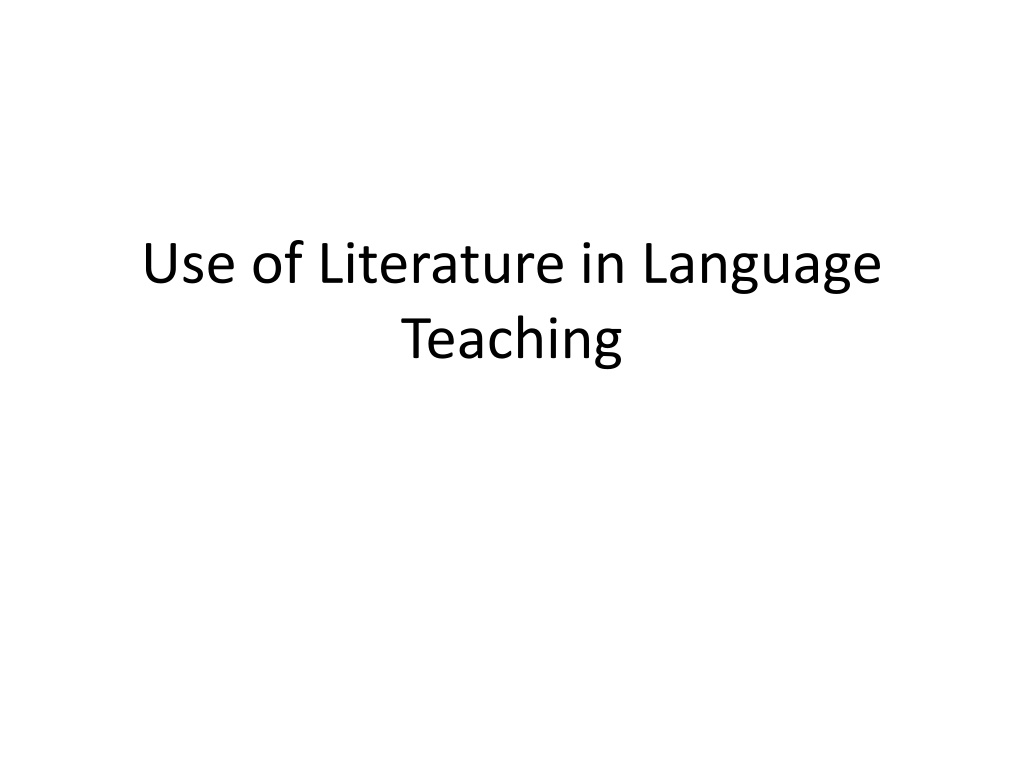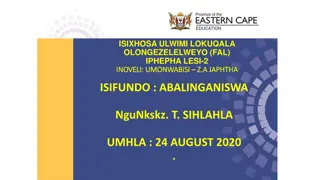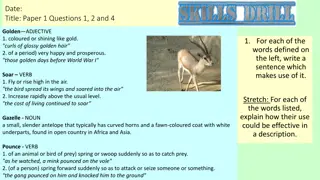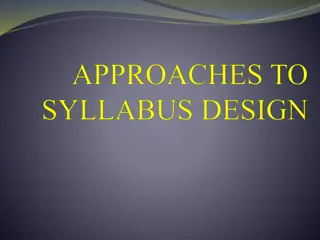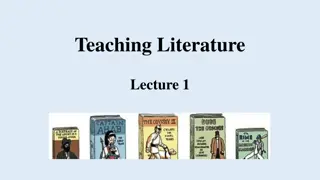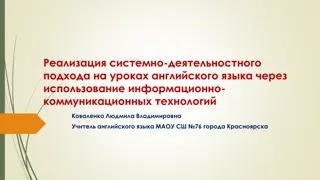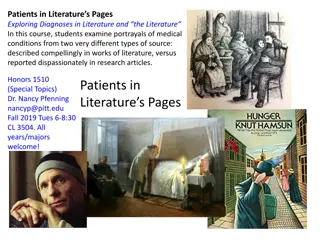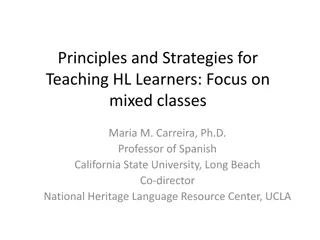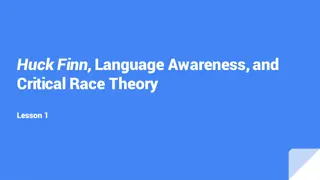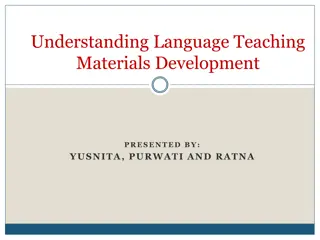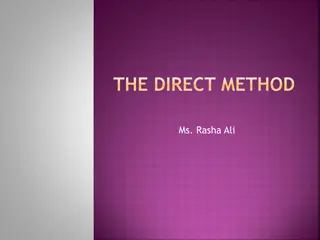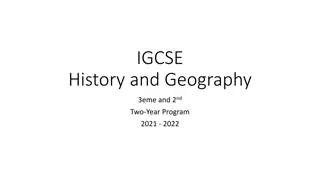Exploring Literature in Language Teaching
Literature plays a significant role in language teaching as it offers authentic materials, motivates learners, and enhances cross-cultural awareness. Literary works help develop language skills and critical thinking while providing insights into cultural aspects and artistic expressions. Various approaches are utilized to study literature in language classrooms, focusing on its linguistic and cultural aspects. The selection of literary materials is crucial, considering criteria such as relevance, engagement, and language complexity.
Download Presentation

Please find below an Image/Link to download the presentation.
The content on the website is provided AS IS for your information and personal use only. It may not be sold, licensed, or shared on other websites without obtaining consent from the author. Download presentation by click this link. If you encounter any issues during the download, it is possible that the publisher has removed the file from their server.
E N D
Presentation Transcript
Use of Literature in Language Teaching
1. What is literature? 2. What is literary language? 3. Do you think literary works are good resources for language teaching? Why/ Why not? 4. What are approaches of the study of literature in the language classroom? 5. What are the criteria for selecting literary materials to teach in the classroom?
Introduction According to Hirsch (1978), literature includes any text which is worthy to be taught to students (p. 34).
What is literature? Literature is composed of literary works in a language by which a community defines themselves. Self-defining activity. Those literary works are defined as artistic and aesthetic. (McFadden, 1978, p. 56).
What is literary language? There are distinctive features in literary texts because of the language used in these texts. Therefore, it is generally demanding to explain an argument in the literary texts.
The study of literature involves an approach to texts as cultural artifacts. Use of literature as a linguistic resource The study of literature also includes : Metalanguage (meaning in varied areas to talk about language, images, texts) Critical concepts knowledge of conventions.
Using literary texts as a source for language teaching Three major benefits of using literary texts in the language classroom: specific communicative goals an ideal resource for integrating the four skills cross-cultural awareness (McKay, 2001).
Why do we use literary texts in the language classroom? As to Lazar (1993), benefits of using literary texts in the language classroom are listed as follows: Motivating Authentic material Educational value Syllabi
Cultural value Stimulus for language acquisition Fun Highly valued/ high status Language awareness Motivating to talk about opinions/ feelings
Sample course objectives for reading literature As to Campbell (2007), the objectives are listed as follows: Students will develop a variety of reading strategies. They will identify the literary terms and study how these terms contribute to their writing skill. They will develop skills to analyze literary texts.
Students will develop discussion skills. Students will discover connections with the literature they read. text to self text to text text to world
Students will understand the role of literature which provides insights into the culture of target language. For instance: A play which allows language learners to participate in the new culture helps them develop sensitivity as to how speakers of the target language interact with each other. (Stern, 1980, p. 209)
Approaches to study of literature 1 .The Cultural Model: language as a cultural artifact study of literary text from social, political, literary and historical perspective (Carter&Long, 1991). 2. The Language Model: contextualized linguistic features (systematic practice) regardless of literary quality of text or reader-text interaction (Carter & Long, 1991).
3. The Personal Growth Model: language learning and cultural awareness personal development focus is on learner s interaction with the text and learner s feelings /ideas/opinions (Carter & Long, 1991).
Approaches to study of literature while teaching English 1) Language Based Approach: study of language of literary text detailed analysis of literary text to improve interpretation skills knowledge of grammatical, lexical/ discoursal categories literary texts regarded as great sources for language activities a wide range of styles and registers (Lazar, 1993).
Open to multiple interpretations along with the classroom discussions Focus on interesting topic (Lazar, 1993). One of the Possible negative aspects of this approach is: If the analysis of the text is made in purely linguistic terms, this approach to study of literature becomes mechanic (Lazar, 1993).
2. Literature as content Literature is the content of the course Focus is on such areas as: history and characteristics of the literary movements or periods social, political, and historical background to a text. literary genres and rhetorical devices
Reading texts along with literary criticism helps learners acquire English. The teacher can also ask students to translate these texts into their mother tongue. Meaning emerges in literary and historical context.
One of the possible negative aspects of this approach is: If the literary text is difficult linguistically, students may depend on the teacher s ready- made interpretations.
Therefore, the background information to be supplied in this approach is important. Biographical information about the author Historical/ mythological events or characters Philosophical, political or religious ideas in the text . Places, objects or other texts referred to in a text
Genre of the text (drama, poetry, fairy tales, short story, folklore and to name a few) relationship between the text and literary periods or movements historical, political or social background against which the text was written.
3.Literature for personal enrichment Literature as a tool for encouraging students to express their feelings and verbalize their ideas It involves learner as a whole person. Material is thematically organized along with non-literary texts (Lazar, 1993).
Using this approach may be a problem while teaching English Some texts may be so remote from the students own experiences. In addition, some students may not find pleasure in discussing about their own feelings/ emotions or reactions.
Personal Enrichment Model and Humanistic Approach to Language Teaching by Williams and Burden (1997) Involving learner s as a whole person Engaging feelings/ emotions Developing identity Encouraging self-knowledge and self-evaluation Establishing a sense of personal value in learners Encouraging Creativity
Selecting materials According to Lazar (1993), there are three things to be taken into consideration while selecting the literary materials. These are: learners cultural background learners linguistic proficiency learners literary background
Important Issues while Selecting the Materials by Coser (2011) Literary text should capture the students interest Literary text should be suitable for the intended level, age group, interests, cultural background
A variety of genres and styles should be taken into consideration Text should be associated with other media Text should fulfill teacher s literary objectives
